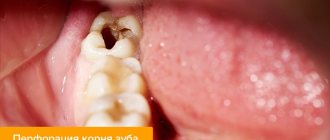A purulent formation on the gum is popularly called gumboil. Very often it is not taken seriously, but it is not just a small swelling that will go away on its own. Flux is an ontogenic periostitis, a complex infectious disease that affects the periosteum and jaw bone. Periostitis occurs quite often, but without adequate treatment it is fraught with serious complications, including blood poisoning.
It is almost impossible to cure gumboil without the help of a dentist. The treatment program includes therapeutic, physiotherapeutic, and surgical methods.
Have you noticed purulent formations on your gums and swelling of your cheeks? Do you have acute pain in your tooth or gum? Come for a consultation with a dentist at our clinic. Timely treatment of flux allows you to get rid of the problem within about 7 days.
Why does flux form?
Dental diseases are always the precursor to gumboil. Most often lead to suppuration:
- Untreated caries. If caries is not treated, the inflammatory process begins to spread to other tissues. Pulpitis and periodontitis gradually develop.
- Mechanical injury. Injury can lead to more than just crown destruction. Very often, an inflammatory process develops in injured tooth or gum tissues. Without treatment, purulent processes develop and gumboil forms.
- Periodontitis. In more than half of the cases, gumboil develops precisely against the background of periodontitis, as its complication. This is due to the fact that purulent processes from periodontal pockets can spread to the neck of the tooth.
- Poorly sealed canals. Before filling, the canals must be completely cleaned and the filling material must completely fill the cavity. If at least one of the conditions is violated, the infection from the canal spreads to other tissues.
Prevention of periostitis
To prevent re-infection, a number of preventive measures should be followed:
- systematically take the animal for examination to the veterinarian,
- do preventive treatment of the oral cavity at least once a year;
- periodically clean the dog’s teeth using gauze soaked in a soda-based solution;
- include industrial dry food in the nutrition plan.
In addition, it is necessary to supplement the diet with sugar bones, which will help the pet grind and clean its teeth.
Some owners believe that it is possible to limit the diet of their four-legged friends to soft canned food. This opinion is wrong. Such a neglectful attitude towards the physical condition of the pet leads to the formation of tartar, which provokes the development of gumboil and other inflammatory diseases of the oral cavity.
When do you need dental help?
Flux has pronounced symptoms. The main one is the appearance of an abscess on the gum next to the diseased tooth. The abscess develops gradually. At first, the gums swell a little and a small red or whitish bump is noticeable on it. After some time, a noticeable fistulous tract forms on the lump, from which pus flows. The development of periostitis is accompanied by other symptoms:
- Swelling and swelling of the gums, lips, cheeks. Sometimes they can be so large that facial features are distorted.
- Severe cutting pain in the tooth area. Innervates the temporal region, orbits.
- The diseased tooth begins to become very loose, even if there was no mobility before or it was insignificant.
Since flux is caused by infection, it is characterized by symptoms that appear during any infectious process. The patient feels unwell, his temperature rises, his head hurts, and weakness appears. Lymph nodes on the head and neck become enlarged.
Any of these symptoms is a reason to consult a doctor. The more advanced the case, the higher the risk of complications. This disease is often accompanied by other pathological processes. For example, a cyst may form in tissues affected by infection.
Symptoms and signs
The first sign of a problem is that the dog wants to eat, but cannot.
- The animal walks in circles around the food, whines, tries to grab the food with its lips, but cannot chew and throws it away.
- The same thing happens with drinking, however, if the water is at the optimal temperature, then the pet can take a few sips.
- The inability to eat is explained by severe pain, and the dog’s entire jaw hurts.
- During sleep, he suddenly jumps up, behaves restlessly, and whines.
- A more detailed examination reveals loose teeth.
- After drinking, you can see blood in a container of water.
- The animal has a fetid odor from the oral cavity and continuous profuse salivation.
- If the upper part of the jaw is affected, nosebleeds may be recorded.
During the period of illness, the dog is unable to eat normally.
Serous flux
In serous cases, there is slight swelling of the jaw and the periosteum is swollen. With this type of flow, the animal does not experience severe discomfort and can behave with virtually no changes.
With serous flux, the dog's jaw swells slightly.
Purulent flux
Purulent flux is characterized by the formation of pustular wounds on the affected gum. The body temperature rises, the entire oral cavity is swollen and painful, bright red. A pungent smell of rotting from the mouth, profuse salivation.
Purulent flux is characterized by increased body temperature.
Diffuse flux
During a diffuse course, the animal feels extremely ill. Aggression gives way to apathy, the dog lies down and whines pitifully. Constantly rubs his face with his paws. The body temperature is significantly increased, yellow saliva, possibly mixed with blood, continuously flows from the mouth.
With diffuse flux, the dog becomes apathetic.
Flux treatment methods
Treatment should be started as early as possible. If an abscess on the gum opens spontaneously, there is a risk of infection entering the bloodstream. With such an infection, blood poisoning develops, and such a complication can lead to serious consequences, including the death of the patient.
Flux treatment is always complex. The treatment program depends on the degree of tooth decay and the spread of infection.
Dentistry for those who love to smile
+7
Make an appointment
Animal care
During treatment, provide your four-legged pet with complete rest. Temporarily limit his activity by refusing training and participation in sports disciplines.
To avoid bone problems, review your current diet. Basic food products must contain sufficient amounts of phosphorus, calcium and vitamin D. If this is not possible, then the listed vitamins and minerals can be obtained from special complexes.
Until recovery, all food should be soft and warm. The absence of hard pieces and high temperatures will prevent injury to the already affected oral cavity.
Clean water and food bowls more thoroughly than before - using mild detergents and plenty of warm water. The animal's feeding area must be spotlessly clean so that there is no chance of secondary infection.
Opening an abscess on the gum
The abscess is always opened. This reduces the risk of spontaneous opening, which can cause complications. The flux is opened under local anesthesia. If the patient has panic or other indications, the doctor may choose a different method of anesthesia.
A small incision is made on the anesthetized gum in the area of the gumboil, no more than 2 cm in length. After the dissection, the doctor completely cleans and sterilizes the purulent cavity and treats it with antiseptics. A crust should not be allowed to form in the area of the incision, as it will interfere with the outflow of ichor and purulent contents. To do this, a drainage is inserted into the incision. After the cavity is cleared of pus, you can begin general treatment, the purpose of which is to eliminate the causes that caused periostitis.
The dog's face is swollen
When 's face is swollen, some owners find it very touching. Although slitted eyes and a tender expression cannot be considered the norm, the pathological condition can sometimes turn out to be very dangerous. The simplest thing is minor damage to the skin from a bite, wounds that give a slight swelling. The most difficult thing is an allergic reaction (Quincke's edema), which affects not only the dermis, but also spreads to the internal tissues of the trachea and pharynx, causing suffocation.
General treatment
Methods depend on the reasons that caused the flux. The only exception is periostitis, which develops against the background of periodontitis. In this case, immediately after opening the abscess, the doctor begins periodontal treatment. No medical manipulations with the tooth are required. In other cases of dental disease you need to treat:
- Pulpitis. First, the dentist drills out carious cavities and performs pulp removal. After this, endodontic canal treatment is performed.
- Periodontitis. Treatment depends on whether depulpation and canal filling have been previously performed. If periodontitis has developed for the first time, the doctor will remove the pulp, clean and fill the canals. If filling of the canals has already been performed previously, they need to be unfilled and treated again. Since it is very important that the pus comes out of the flux completely, when treating complicated pulpitis and periodontitis, a temporary filling is not placed.
- Tooth after restoration. At the first stage, the doctor is faced with the task of completely removing inflammation. After this, the damaged tissue of the root apex is removed. If the condition of the root allows, the tooth is restored again using a core tab or pin and an artificial crown. When the damage is very severe, it is more advisable to remove the tooth.
How is the disease diagnosed?
First, the veterinarian will listen to the animal owner. It is important for him to clarify what preceded the disease and what symptoms were noticed. Then a complete analysis of the blood and its chemical composition will be carried out. This is necessary to assess the overall health of the pet.
Find out what to do if your dog's teeth are falling out.
A tissue sample (biopsy) is not done very often - only if a tumor is suspected. In this case, the type of tumor and the degree of its development will be determined. Dental X-rays are often prescribed to identify changes in bone tissue and find out the condition of the jaw bones.
Physiotherapy
Physiotherapeutic methods are used as additional ones. They allow you to quickly cope with the infection and stop the inflammatory process. The following methods can achieve good results:
- Fluctuarization. The inflamed tissues are exposed to low voltage current.
- Electrophoresis with lidase. Electrical current is applied to the tissue, allowing the drug to be effectively distributed.
- Ultrahigh frequency therapy. The method is based on the influence of an electromagnetic field.
- Ultrasound therapy. The effect of ultrasound on infected tissues accelerates their regeneration.
- Laser therapy. Damaged tooth tissue is treated with a laser beam.
Causes of tumor formation
The main reason for the appearance of gumboil in dogs is insufficient oral hygiene. Due to the lack of regular brushing of teeth, food particles accumulate and harden on the enamel. The resulting tartar expands the space between the gums and teeth. Pieces of food stuck in this gap rot and create pathogenic microflora that attract bacteria.
In addition to insufficient hyena, owners should pay attention to other provoking factors:
- complications of other oral pathologies (stomatitis, pulpitis, gingivitis);
- gum injuries from hard and sharp objects;
- hypothermia, colds and stress that weaken the immune system;
- lack of solid food in the diet, which prevents the natural removal of plaque from the enamel (abuse of soft canned food);
- secondary infection after removal of a diseased tooth;
- inflammation of the gum pocket - a favorite place for most harmful microorganisms.
As a result of a protracted inflammatory process, unilateral or bilateral swelling occurs on the animal’s face. The affected side increases in size, frightening the owners with its appearance.
Rinse
They are used as an additional treatment in order to completely remove pus and ichor from an opened abscess and prevent the infection from spreading to healthy areas. Soda-salt baths and rinsing with antiseptic solutions help make treatment more effective and speed up gum healing. When rinsing, you must adhere to the following rules:
- During the day, do 4-5 gentle rinses or baths. To do this, just take the solution into your mouth and hold it for about 30 seconds.
- During the day, do 4-5 gentle rinses or baths. To do this, just take the solution into your mouth and hold it for about 30 seconds.











